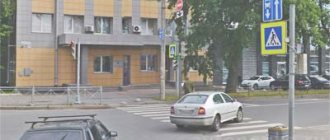Traffic rules for trams are slightly different than for cars, despite the fact that they travel on roads that intersect with cars and pedestrians. And more often than not, rail transport has an advantage, but not always.
In most cases, cars should allow the opponent to pass. And yet there are cases when a tram must give way to a car:
- at an intersection where traffic is regulated by a traffic light, if a rail vehicle is moving in the direction indicated by the arrow on the additional section, it must be turned on simultaneously with the yellow or red signal, and the car must move to the green light;
- at an intersection where there is no traffic light, but there is a distinction between the main and secondary roads - a tram moving along the secondary road must allow a car to pass;
- when a rail vehicle leaves the depot;
- when encountering an emergency vehicle with beacons and a sound siren; when entering a roundabout intersection.
If a car and a rail vehicle traveling along perpendicular tracks meet at a controlled intersection, the latter sometimes has to wait. According to the rules, the tram is obliged to allow the car to complete the turn or pass through this zone if it has already begun the maneuver. And only then drive under the green light.
The tram must give way to a pedestrian in the following cases:
- if a vehicle traveling on rails makes a turn, it must first let a pedestrian or cyclist pass;
- if a rail vehicle is at a controlled intersection and the red light is on, you can go after the green one when people have finished moving;
- if you approach a crossing without a traffic light or a traffic controller;
- if a rail vehicle approaches a pedestrian crossing regulated by a traffic light;
- if he sees a blind pedestrian (with a white cane) on the roadway;
- if a person is in a hurry to a public transport stop, having just left such a bus or minibus;
- if these are children who are walking across the roadway towards a vehicle with a “Transportation of Children” sign, the bus or car must be parked with the emergency lights on.
Which driver must give way to the tram:
- a motorist, if the car and the rail vehicle are at a controlled intersection;
- a motorist if his vehicle is traveling in the same direction as his opponent at an intersection of unequal paths;
- a motorist, if he and a second participant in the movement find themselves at the intersection of equivalent paths, the trackless vehicle yields in any case, even when it itself approaches the opponent on the right.
The situations listed also apply to those who drive a motorcycle, moped, tractor, bicycle, or truck.
Also, the tram must give way if:
- there is a railway crossing on its way, the first to cross it is a train, a locomotive or a handcar;
- at a controlled intersection there are two rail vehicles of the same type - the one going right or straight has priority;
- At an unregulated intersection of roads of equal importance, there are two trams; the one approaching the second one from the right must go first, but both rail vehicles must travel along the main road or in the same train along the secondary road.
More on InDrive.Net:
Symbol 4.1.1, or the sign “Move straight ahead”: features of the passage that the sign prohibits
A fine of 1,500 rubles is provided for violators. under Article 12.13 of the Code of Administrative Offences.
Read more in our article about in what cases a tram must give way.
In this article:
In what case is it obligatory to give way to a tram?
In what cases is it necessary to give way to trams, and in what cases not? A tram always has an advantage over trackless transport except in three cases:
- when the tram moves to a switch turned on in an additional section at the same time as a red or yellow traffic light. In this case, the tram must give way to vehicles moving from other directions.
- when a tram approaches an intersection along a secondary road;
- when the tram leaves the depot and the tram tracks cross the roadway (clauses 18.1 and 13.6. Traffic rules)
The first case refers to the passage of controlled intersections, the second case - to the passage of uncontrolled intersections
Please note that at an equivalent intersection, the “obstruction on the right” rule applies only when driving around with trackless vehicles
Traffic rules: in what three cases does a tram give way to a car?
From this rule we can conclude that at an intersection a tram cannot take advantage of trackless vehicles only in 3 cases: 1) if at a controlled intersection it is prohibited from moving by a traffic light or a traffic controller; 2) if the tram moves along an additional section of the traffic light to the main prohibiting signal; 3) if the tram is on a secondary road, and the trackless vehicle is on the main road; Thus, the tram cannot take advantage in the three described cases at the intersection, as well as outside the intersection - when leaving the depot. Other cases should be perceived by drivers of trackless vehicles as situations where it is mandatory to give way to the tram.
Controlled and unregulated intersections with tram tracks
This requirement was written down in the “Street Rules”, which ended in 1973!!! The current traffic regulations have one requirement - give way to pedestrians! Therefore, we need to focus not on “soulless pieces of hardware”, but on people! If the tram is at its stop, but there is not a single pedestrian passenger who you could interfere with, you can calmly (but carefully) start moving! Movement along tram tracks Now about the use of tram tracks. Is it possible to move along them if the entire road is clogged with cars? How to make a U-turn, drive onto the rails or not? There are answers to these questions. If you open the traffic rules and carefully study all the paragraphs that contain information on this topic (p.
9.6, 8.5, etc.), then an interesting conclusion can be drawn for the section of road between intersections.
Tram tracks at a traffic light-controlled intersection
In this case, the passage of the intersection is regulated by paragraph 13.6 of the traffic rules:
13.6. If traffic lights or traffic controller signals allow the movement of a tram and trackless vehicles at the same time, then the tram has priority regardless of the direction of its movement. However, when moving in the direction of the arrow turned on in the additional section simultaneously with a red or yellow traffic light, the tram must give way to vehicles moving from other directions.
In most cases, at intersections regulated by traffic lights, rail vehicles have priority trams .
The only exception to this rule is the situation when the tram turns under the green arrow turned on in the additional section at the same time as the red or yellow signal. In this case, car drivers have an advantage. This is exactly the situation shown in the picture above, where a tram gives way to blue and white cars.
Please note that if the car and the tram are moving from different directions (as in the figure above), then the driver of the car cannot determine whether the tram is going to the green signal in the additional section or to the regular green signal.
If we look at the situation from the other side and evaluate the consequences of an accident for the tram driver and the car driver, it becomes obvious that the car driver is always a loser, because The car suffers significant damage due to its low weight. An example of such an accident is presented in the video:
The only conclusion that can be drawn from all of the above is that at intersections regulated by traffic lights, you should always give way to a tram that has started moving.
What a driver should remember and the most problematic issues
Ticket 40, question 11
On equal roads, oncoming and passing traffic, a tram has an advantage over any trackless vehicle, and no driver should forget this rule. At the same time, you need to remember the three exceptions described above, in which electric vehicles give way to cars first.
At first glance, situations when you need to give way to a tram are clear and simple, but in practice, thanks to tram tracks, drivers face several more difficulties:
- traffic in the area of the tram stop (who lets whom through);
- movement on rails (is this permissible);
- intersections with tram tracks and the use of additional signs.
Violation of the Rules and when legal assistance is needed
The most frequent and common situations that will help you behave correctly on the road, understand when and to whom you should yield in order to avoid violations of the Traffic Rules are discussed above. But cases are different, especially when one of the participants does not understand all the nuances or when participants use signs and clauses of the Rules that contradict each other.
All situations require separate consideration, so it makes sense to seek help from a specialist in the field of auto law. Moreover, you cannot do without legal assistance if a violation of the Rules led to an accident and legal proceedings.
- Tram on the road: when it has the right of way, passing rules
- In what cases does the tram have priority?
- In what cases does the tram have no advantage?
- Rules for traveling with trams
Read more: Homemade foam generator for washing
According to the Traffic Rules, a tram is a type of transport that has a special road status. And it has an advantage over vehicles when passing. In the article you will find explanations of the rules for passing a car with a rail vehicle and the features of crossing intersections.
What you need to know when approaching a tram stop
Overtaking on the highway at an intersection. Overtaking at an intersection and possible fines. Is overtaking allowed at signalized intersections?
The most dangerous sections of the road, in the middle of which there are tram tracks, are stops, so the driver of a motor vehicle should assess the situation in advance and decide: should he stop and give way to passing passengers or not?
- If a special “island” is not allocated in the stopping area for waiting for public transport, then passengers remain on the sidewalk until the tram arrives, and as soon as it arrives and stops, they have the right to cross the roadway, and car drivers are obliged to stop and let them pass. In this case, you need to focus primarily on people, and not look at whether the tram driver opened the doors. Modern rules say that you need to give way to a pedestrian.
- If there is a special “island” for waiting in the stop area, then passengers wait for public transport there, and no interference should be created with traffic.
Features of maneuverability on roads containing tram tracks
The issues of maneuverability in those areas where there are tram tracks remain especially difficult for many. According to the Rules, if rails are laid on the left in the direction of travel of the car at the same level with the general road surface, then in order to overtake or bypass the car in front in the absence of a tram on the tracks, the driver can enter those areas that touch passing traffic. Driving in the opposite direction is strictly prohibited!
The issues of intersections, turns and U-turns remain problematic. The rules stipulate that in preparation for a turn/turn, the car moves to the tram tracks in the same direction and makes a maneuver from them (if there is no “Lane Directions” sign). It is important to remember that the same Rules establish that the driver is prohibited from obstructing the progress of the tram, which remains dominant on equivalent roads. In this case, you need to independently assess the situation and pay attention to the distance separating the vehicles:
- if the tram car is distant and the car has time to turn, then you should do so;
- if the tram car is close, then the car must slow down and give way to the tram, and then move onto the rails after it.
Amounts of punishment
Traffic rules knowledge test
Russian legislation provides for a system of penalties for moving along a rail track.
The penalties are shown in the table below:
| Description | Fine (in rubles) |
| Driving a car on rails crossing a continuous marking line. | 500 —1500 |
| Driving onto rails in the same direction under prohibitory signs. | 500 — 3 000 |
| Moving along the rails for a tram in the opposite direction. | 5000 |
| Driving onto oncoming rails due to the need to bypass an obstacle that has appeared on the route. | 1000—1500 |
| Stopping a car on the tram route. | 1500 — 3000 |
| Permitted driving on a passing rail track, creating interference for trains. | 500 |
In what cases does the tram have no advantage?
There are no benefits in the following cases:
- when leaving the line from the depot;
- when switching from secondary to main;
- when there is a prohibiting traffic light signal.
A moving special vehicle with its special signal turned on has an advantage over any other means of movement. Both rail and trackless vehicles are required to give way to him.
Nuances of movement, U-turns and turns on tram tracks
Sometimes circumstances develop in such a way that an acute lack of time provokes drivers to take risky maneuvers to make up for the deficit. Meanwhile, the Traffic Rules in the current version allow driving straight along tram tracks if there is a traffic jam on the road. You just need to follow some conditions:
- the actions of the motorist must not interfere with the movement of public rail transport;
- the rail bed must be in the same direction and be level or slightly below the road;
- You can drive if there are no signs 5.15.1 in front of the intersection. “Direction of traffic along lanes” and 5.15.2. “Lane direction”;
- if exit onto the tram tracks is not impeded by road markings (a solid line or markings regulating the directions of movement along the lanes).
You can only enter the oncoming lane to avoid obstacles (accidents, repair work, etc.), when it is not possible to avoid the problem area in any other way.
Left turn
In accordance with clause 8.5 of the traffic rules, before making a left turn or a U-turn, the driver is obliged to occupy the leftmost lane in advance, and if there are rail tracks on the left in the same direction, begin the maneuver from them. Naturally, the rails should not be significantly higher or lower than the road. Otherwise, they serve as a dividing strip. There should also be no signs 5.15.1. and 5.15.2.
It follows from this rule that if the driver starts a U-turn or a left turn away from the tram tracks, in the absence of reasons provided for by law, this will be an absolute violation of traffic rules.
U-turn
The rules do not define the term “reversal.” In practical driving, a U-turn is the process of moving a vehicle to the opposite lane from the original one: the driver first drives in one direction, then turns around and heads in the other.
The rules for turning on public transport rails are identical to the rules established for turning left:
You should take the far left lane (tram rails in this case), making sure that such a maneuver does not contradict the Traffic Rules: there are no signs regulating the direction of movement, road markings do not prohibit turning and turning, the rail bed is at the same level as the road. Make sure that the maneuver is safe: the lane of not only passing trams, but also of oncoming trams must be clear. If rail transport is in close proximity, it is better to postpone the maneuver and let the tram pass
You also need to pay attention to the distance from the car moving in the oncoming lane to the place of the planned turn.
Right turn
Turning right from tram tracks is prohibited (driving into a lane intended for oncoming traffic is charged). Only from the far right lane of the road.
U-turn at an intersection
In order to change direction at an intersection, you should follow the general rules for turning left and making a U-turn. The only difference in the maneuver algorithm is the presence of traffic lights or the work of a traffic controller separating traffic flows.
Based on clause 13.6 of the Traffic Rules, if a section of a traffic light is green or the traffic controller has built a combination that allows all vehicles to move, including trams, then trackless vehicles will have priority over cars. Accordingly, before making a turn and U-turn, the driver of the car is obliged to let the tram pass.
If the traffic light is equipped with an additional section that allows turns when the main signal is red or yellow, then in this case the driver must allow wheeled vehicles to pass, regardless of the direction of its movement.
In the video about the rules for turning around on tram tracks.
Types and amounts of fines for tram tracks
The legislator establishes the following liability for offenses in this area:
- For an accident that occurs on tram rails, the driver may be subject to administrative and criminal prosecution: according to Article 12.24 of the Code of Administrative Offenses of the Russian Federation, penalties of up to 25 thousand rubles are provided. or imprisonment for up to two years; under Article 264 of the Criminal Code of the Russian Federation - up to 9 years, depending on the consequences of the incident.
- Entry onto the path of the opposite direction entails liability in the form of a fine in the amount of 5 thousand rubles or deprivation of a driver’s license for a period of 4 to 6 months under Part 4 of Art. 12.15 Code of Administrative Offenses of the Russian Federation.
- If the car owner does not drive onto the far left side of the rails when making a left turn, he faces a warning or an administrative fine of 500 rubles under Part 1.1 of Art. 12.14 of the Code of Administrative Offenses of the Russian Federation, the same fine is established for an incorrect turn on the tracks.
- For forced downtime of a tram due to interference by the driver, a warning or a fine of 500 rubles is provided under Part 3 of Art. 12.14 Code of Administrative Offenses of the Russian Federation.
- If, during the passage of a controlled intersection, an obstacle is created to a tram that has priority, penalties in the amount of 1 thousand rubles are provided under Part 2 of Art. 12.13 Code of Administrative Offenses of the Russian Federation.
Situations in which a tram gives way
Indeed, almost always the tram goes first, and there are only three exceptions:
- if a car is traveling on the main road, and a tram is traveling on a secondary road. This situation is 100% compliant with the rule that when crossing unequal roads, the driver of a vehicle (any vehicle, without distinction between types (passenger, etc.)) walking in the secondary lane is obliged to give way to someone moving on the main lane regardless on what its further direction of movement is;
- if the path is cleared for a car by a green traffic light, and for a tram only the green arrow is lit simultaneously with the red or yellow signal;
- if the car is moving along the road, and the tram car is just leaving the depot.
In principle, having figured out in what cases a tram gives way to a car, problems in road traffic should not arise.
Rules for traveling with trams
As a separate situation, the movement of two trams should be considered. If one is moving straight, and the second one is turning left along the oncoming line, then he is obliged to give way. Regardless of whether the intersection with the intersection of two equivalent routes is regulated or not, the path must be given to the tram that is on the right.
The stop may or may not be equipped with a boarding area, so sometimes tram passengers are on the sidewalk or crossing the road to the boarding point. If there is a landing pad, the passenger must wait there. A moving car is not required to stop. But the passenger may not know about this, so be careful when passing tram stops.
The rules governing tram driving are not particularly complex. For any traffic participant, it is important to simply read and remember the main points when there is no or advantage in the movement of certain vehicles.
Subscribe to our feeds on social networks such as Facebook, Vkontakte, Instagram, Pinterest, Yandex Zen, Twitter and Telegram: all the most interesting automotive events collected in one place.
Many drivers are confident that the tram always has priority in traffic and let it pass in any situation. However, this is not entirely true and can lead to an accident, because the rules clearly indicate the moments in which it is he who is obliged to let other road users pass. So, in what cases should you give way to a tram, and when should you not?
Important! If you are dealing with your own case related to the movement of a tram, then you should remember that:
- All cases related to the tram are unique and individual.
- Understanding the basics of the law is useful, but does not guarantee results.
- The possibility of a positive outcome depends on many factors.









